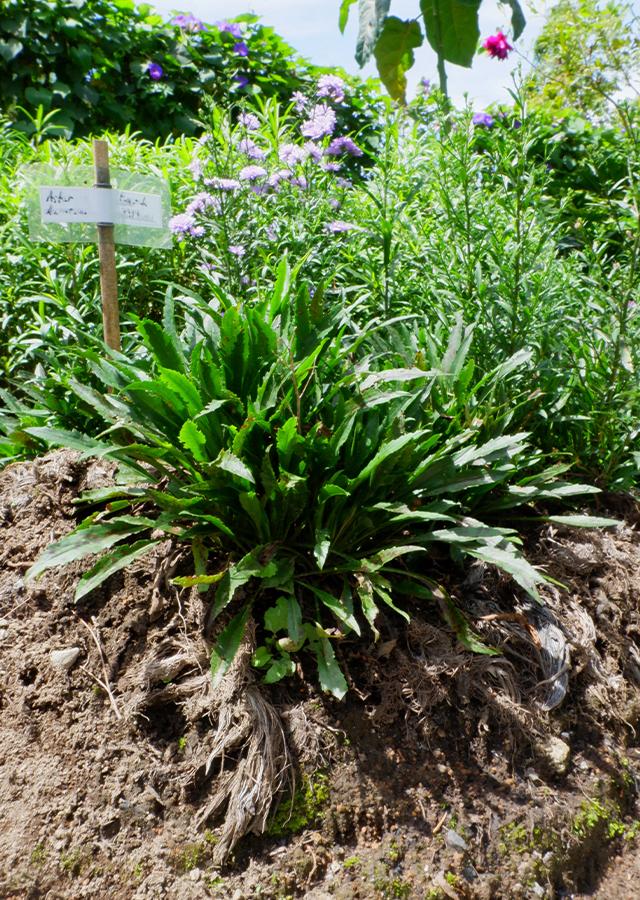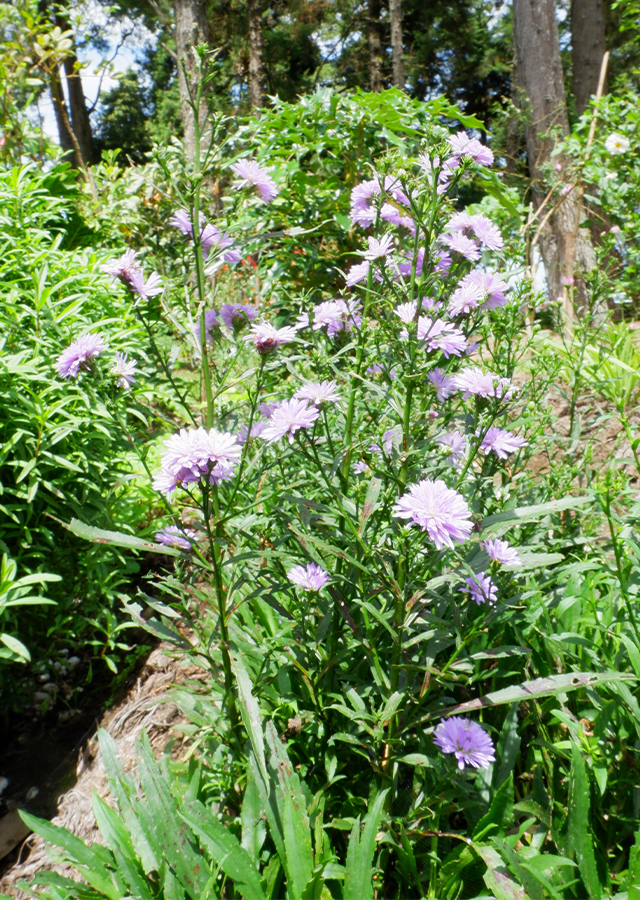Tatarian Aster
Aster tataricus L.f.
Asteraceae
Location in our garden
Principal



Synonym
Aster bracteatus Turcz. ex Herder
Aster conspicuus Fisch. ex Turcz.
Aster faurei H.Lév. & Vaniot
Habitus
Herbaceous. Annual herb, height 11-150 cm
Part Used
Roots
Growing Requirements
Full Sunshine
Need Shade
Habitat
Riverbanks
Mountains
Grassland
Overview
Originated from Siberia which spread to Mongolia, China, Japan, and Korea. This plant is commonly used in traditional Chinese medicine, the root is known in traditional Chinese medicine as zi wan or Radix Asteris Tatarici. The plant is also cultivated, mainly in Korea for medicinal use and is sometimes grown as an ornamental in gardens.
Vernacular Names
No information found. Need further search.
Agroecology
Tatarian aster can survive at an altitude of 400-3300 m asl and a temperature of at least -15 °C. Succeeds in most good garden soils, preferring one that is well drained and moisture resistant. Prefers sunny positions, but also does well in partial shade. Plants can suffer from mold when grown in dry conditions.
Morphology
- Roots - fleshy rhizome, ± woody with age, with abundant fibrous roots.
- Stems - erect, rarely to solid (distal) strigillose.
- Leaves - basal and cauline, very rough, scab edges, mucoid tip, scab face; basalt is usually deciduous with flowering; persistent proximal cauline, petiolate long (petioles ± winged, base sheath), blade 1 strongly innervated, oblanceolate, 300–500 × (50–)60–120 mm, thinned base, wavy edge, recursive, coarsely serrated, mucronate tooth, apex acuminate, pointed, or round; subpetiolate middle and distal to sessile, blade oblanceolate to lanceolate, 40–180 × 10–50 mm, base thinned to pointed, sheathed, edge serrated or entirely, apex pointed to sharp; suddenly reduced distal (array), lanceolate, 5-10 mm, apex acute to acuminate.
- Flowers - heads 14–50+ in corymbiform arrangement, branches ascending. Involucres campanulate, (6.5–)7–10(-12) mm. Phyllaries in series 3-4, ovate to lanceolate (outer) or linear-lanceolate to linear (inside), green to base along the middle or outer nerves sometimes mostly leafy, apex acute (outside) to long pointed (inside), abaxial surface glabrous or slightly strigilose. Rays 14–30; pale lavender or purple laminae, 10-15 × 1.5-2.5 mm. Disc florets (20–)25–30(–50); light yellow corolla turns lavender at least in lobe, (4.5–)5–6 mm, tube approximately along the throat of the campanulate.
- Cypselae - light brown, linear-obconic, slightly compressed or plump, 1.5–2 mm, nerves 4-5(–6), facing glabrate to thin strigillose; pappi white or cream, 6-8 mm, shorter than the corolla disc.
Cultivation
- Propagated by seeds - Germination usually takes place within 2 weeks at 20°c. When large enough to handle, prick the seedlings out into individual pots and plant them out in the summer.
- By basal cuttings - Harvest the shoots when they are about 10 - 15cm long with plenty of underground stem. Pot them up into individual pots and keep them in light shade in a cold frame or greenhouse until they are rooting well. Plant them out in the summer.
- By division - Very easy, larger divisions can be planted straight into their permanent positions whist smaller clumps are best potted up and kept in a cold frame until they are growing away well.
Chemical Constituents
Epifriedelinol, friedelin, friedel-3-ene, astersaponin, quercetin (flavonoid), lachnophyllol, lachnophyllol acetate, aurantiamide acetate, anethole, astersaponins (A, B, C, D, E, F, G), asterprosaponins, hederasaponins (shionosides), asterine, cyclochloro-tine, astin A, B, C, astertarone (triterpenoid), pentapeptides (possibly antibacterial), beta-amyrin (possibly a sedative), oleic acid, aromatic acid, carotene, oleic acid (omega-9 fatty acids), stigmasterol, beta-sitosterol, spinasterol (a triterpene similar to cholesterol, but unsaturated), shionone (triterpene), suberon (subaric acid ketone; peppermint aroma).
Traditional Medicinal Uses
- The root contains triterpenes and triterpene saponins, and is a stimulant expectorant herb for the bronchial system, helping to clear infections. It is antibacterial, antifungal, antitussive, expectorant and stimulant.
- The root is taken internally in the treatment of chronic bronchitis and tuberculosis and is often used raw with honey in order to increase the expectorant effect.
- The plant contains the triterpene epifriedelinol, which has shown anticancer activity, and is used as a folk cure for cancer.
Part Used
Reference Sources
- Royal Botanic Gardens. Plants of the World Online: Aster tataricus L.f.. https://powo.science.kew.org/taxon/urn:lsid:ipni.org:names:182425-1#synonyms. 11-04-22.
- Useful Temperate Plants. 2022. Aster tataricus. http://temperate.theferns.info/plant/Aster+tataricus. 11-04-22.
- Robyn Klein, AHG, MS,. 2007. Preliminary Research on Aster tataricus. Medical Botanist Department of Plant Sciences and Plant Pathology MSU-Bozeman. https://www.academia.edu/2536662/Preliminary_Research_on_Aster_tataricus.
- World Flora Online Data. 2018. Aster tataricus L.f.. http://www.worldfloraonline.org/taxon/wfo-0000135188#C. 11-04-22.

